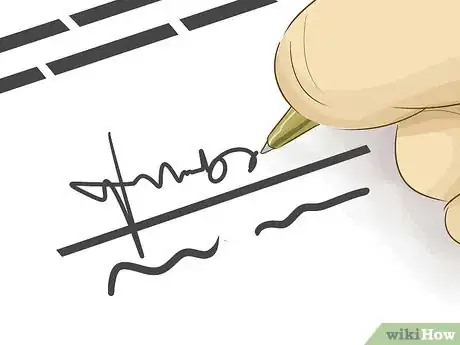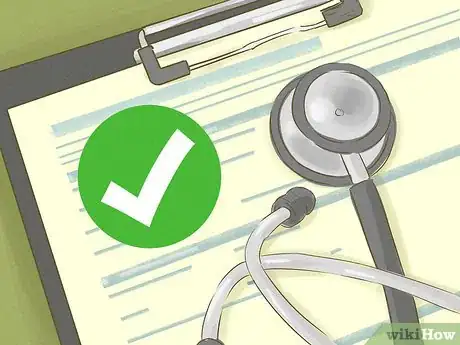This article was co-authored by Clinton M. Sandvick, JD, PhD. Clinton M. Sandvick worked as a civil litigator in California for over 7 years. He received his JD from the University of Wisconsin-Madison in 1998 and his PhD in American History from the University of Oregon in 2013.
There are 16 references cited in this article, which can be found at the bottom of the page.
This article has been viewed 34,091 times.
When you are sued, you always have the option of turning around and counter-suing. This is called bringing a “counterclaim.” In some situations, you are required to bring a counterclaim, especially when it arises from the same incident as the lawsuit filed against you. In order to make a counterclaim, you first draft your response to the lawsuit. Then you need to describe the factual circumstances surrounding your claim and make a demand for compensation or other relief. Be sure you do not confuse counterclaims with cross-complaints. While some states see these terms as interchangeable, other states define a cross-complaint as a lawsuit you bring against a third party, which usually includes co-parties (i.e., not the plaintiff who is suing you).[1]
Steps
Researching Possible Counterclaims
-
1Read the complaint. When you are sued you will be served with a copy of the complaint, which is the court document filed by the plaintiff that starts the case. The complaint will set out the reasons the plaintiff will sue you and the relief being sought. You can use the information you find in the complaint to help you draft your response. For example, if there are facts in the complaint that you believe are untrue, your response needs to bring this up.
-
2Meet with an attorney. If you don’t know what counterclaims to bring, then you might want to meet with an attorney to discuss your case. You can get a referral by contacting your local or state bar association. Once you have the name of an attorney, you should call and schedule a consultation.
- Be sure to ask the attorney what he or she charges.
- At the consultation, describe your situation and ask the attorney what counterclaims he or she thinks you could bring.
Advertisement -
3Identify mandatory counterclaims. You must bring a counterclaim for any injury you suffered as a result of the same transaction or occurrence that gave rise to the lawsuit against you.[2] For example, if you were injured in a car accident, then you need to bring your counterclaim against the other driver who is suing you. This is called a “mandatory” counterclaim. If you don’t bring mandatory counterclaims, then you can’t bring them later in a separate lawsuit.
- You can also bring counterclaims unrelated to the incident that gave rise to the plaintiff’s suit against you. For example, your roommate might sue you for hitting her car when you pulled into the driveway. You could countersue for money she owes you. The debt and the car accident are unrelated, so it is a “permissive” counterclaim. You are not required to bring permissive counterclaims, but for the sake of efficiency you could.[3]
-
4Perform legal research. Before you can bring your counterclaim, you need to understand what you have to prove. You should perform some basic legal research. You should look for the following:
- Pattern jury instructions. Jury instructions nicely lay out the different legal elements you need to prove to win your cause of action. Many states publish their jury instructions online.[4] [5] [6] You can search for “your state” and “jury instructions.” Then find the instructions that relate to your cause of action.
- Court opinions. Court opinions also explain the law in a helpful way. You can find court opinions at Google Scholar.[7] Click on “case law” and then select your court. Type in the cause of action you want to bring, e.g., “fraud” and read through the court opinions.
-
5Identify the elements of your claim. Once you have gathered your legal research, you should look to see what elements you must prove in order to win your suit. Regardless of your cause of action, you must allege each element in your counterclaim and you must ultimately prove each element at trial. For example, “negligence” has four elements:[8]
- Duty. The person you are suing owed you a duty of reasonable care. You can often prove a duty where you had a professional relationship with someone, e.g., you hired a doctor or carpenter. Sometimes duties are created simply by how physically close you are. You owe the cars around you a duty to drive carefully on the road.
- Breach. To sue for negligence, the person who owed you a duty had to have broken that duty. In other words, they didn’t exercise reasonable care.
- Causation. The failure to exercise reasonable care must have been the cause of your injury.
- Damages. You must have in fact been injured. If a doctor gives you the wrong medicine, but you aren’t injured, then you don’t have a negligence suit.
Drafting Your Counterclaim
-
1Determine when you will make your counterclaim. At the federal level, counterclaims generally need to be included with your responsive pleading (i.e., your answer). However, if the counterclaim arose after you have already filed your responsive pleading, the court may allow you to file a supplemental pleading.[9]
- If you are filing a counterclaim in state court, check with your state's rules to make sure you file in the correct manner.
-
2Insert a section for your counterclaims. You will include your counterclaims underneath your response to the plaintiff’s complaint. Generally, you will file either an “answer” or a “motion to dismiss” as your response. Type “Counterclaims” in bold, all caps, and center the word between the left and right-hand margins.[10] For example, in federal court, most counterclaims are made as part of your initial responsive pleading (i.e., answer).
- In some situations, you might not become aware that you have a counterclaim until you have already responded to the lawsuit. If the judge gives you permission, then you can file a separate counterclaim. In this situation, you will need to draft a new pleading.
- The pleading will be set up like the complaint you received: same caption information, formatting, etc. But you would title the document “Defendant’s Counterclaim Against Plaintiff for Negligence” or something similar.
-
3Add an introduction. You can briefly state that you are bringing a counterclaim. You can identify the parties as well. For example, you could state:
- “For her counterclaim against plaintiff Acme Construction, defendant Lisa L. Jones hereby states as follows….”[11]
-
4Explain the general factual circumstances. You should give the judge some idea of the factual circumstances of the dispute between you and the plaintiff. Make sure to provide the following information, at a minimum:[12]
- Identify yourself and the person you are suing. If either you or the plaintiff is a corporation, then identify the state of incorporation and where the primary office is located.
- Provide dates and other information for the incident that is the subject of your counterclaim. For example, if you were in a car crash on August 1, 2015, then state the date and location of the crash.
- Allege that the person you are suing (who is the “defendant” for purposes of your counterclaim) violated the law in some way. For example, “Defendant’s negligent course of conduct injured Plaintiff.”
-
5Identify your causes of action. After laying out the general factual background, you can go down through each individual cause of action. A cause of action is a legal claim. For example, negligence, fraud, theft, and breach of contract are all individual causes of action. In federal court, you must state any claim you have against the plaintiff. There are very few circumstances where you do not have to state your claims in the initial responsive pleading (e.g., when the claim is currently the subject of ongoing litigation elsewhere).[13]
- Use section headings for each cause of action. For example, you could write, “Count One—Negligence by Acme Construction,” “Count Two—Fraud by Acme Construction,” etc.
- Be sure to allege each element for the cause of action. For example, if you are suing for negligence, then you would need to allege all four elements: duty, breach of the duty, causation, and damages.[14] Accordingly, you would state, “Acme Construction owed Plaintiff a duty to use reasonable care after Plaintiff hired Acme to remodel her kitchen.”
-
6State what remedy you want. A “remedy” is what you request the judge give you if you win. In federal court, the relief you seek does not need to be the same as the relief sought by the plaintiff, nor does it need to diminish or defeat the plaintiff's relief being sought.[15] Generally, you will probably sue for money damages. You can put an estimated number in your counterclaim, or instead sue for “compensatory damages to be determined.” In addition to compensatory damages, you could get the following:
- Punitive damages. Whereas compensatory damages are meant to reimburse you for your financial loss, punitive damages are meant to punish the person you are suing.[16] Often, they are a multiple of your compensatory damages. Punitive damages may be available if the person you are suing hurt you intentionally.
- Prejudgment and/or post-judgment interest. In some situations, such as a contract case, you can get interest on the amount owed to you from the date the contract was breached. This interest is meant to compensate you for the loss of your use of money.[17] You may also qualify for post-judgment interest from the date you win the lawsuit to the date you get paid.
- Attorney’s fees and costs, if available by law. For some causes of action, you can be reimbursed for the costs of the lawsuit and for your attorney’s fees if you win.
- Other relief as deemed appropriate. This is a good “catch-all” to include in your counterclaim.
-
7Insert your signature block. You have to sign your answer and counterclaim, so insert the words “Respectfully submitted” above the signature line. Beneath the line, include your name, address, phone number, and email address.[18]
- If you are representing yourself in the lawsuit, include the words “pro se” or “pro per” after your name.
-
8Provide notice to the other side. You need to make sure the other side gets a copy of your answer as well as the counterclaim. You should have someone 18 or older, who is not a party to the lawsuit, hand deliver or mail the answer and counterclaim to the plaintiff. If the plaintiff has an attorney, serve the attorney.[19]
- In many counties, you can pay the sheriff a small fee to make hand delivery, or you could hire a private process server.
- Depending on your court, your server may need to fill out a “proof of service” form, which you can get from the court clerk.
- In other courts, you need to include a “certificate of service” as part of your answer. This should be on a separate piece of paper, titled “Certificate of Service,” and state the day you served the answer on the plaintiff, as well as the method of service (hand delivery, first class mail, etc.) Sign your certificate.
-
9File your counterclaim. Once you have completed your answer and counterclaim, you should make several copies of the completed document. Take the original and copies to the court clerk and ask to file.[20]
- You might have to pay a filing fee, which will depend on the court. Call ahead of time to check the amount and method of payment.
- Remember to include your certificate of service or the original, signed proof of service form with the answer you file with the court.
Gathering Evidence
-
1Take photographs of the scene of an accident. If you were injured in a car accident or in a slip-and-fall, then you will want to document the place where the accident happened. You should have someone return as soon as possible and take photographs of the scene.
- Try to take photographs during the same time of day. Also take pictures from many different angles.[21]
-
2Identify witnesses. Witnesses will be critical, because they can serve as unbiased witnesses to the incident. If you are too injured to talk to people, ask someone at the scene to take down the names and contact information of witnesses.
- You should also get a copy of the police report, which often contains the names of witnesses.[22]
-
3Find documents that show financial injury. You may be suing for a financial injury. For example, someone might have broken a contract with you. In situations where you are claiming a financial injury, you need proof of that injury.
- If you had to pay money to fix a problem caused by someone else, then get receipts. You can be reimbursed for any money spent treating an injury, fixing your car, etc.
- If you were unable to work because of the injury, then gather proof of your income. Get W-2 forms, pay stubs, or tax returns.
-
4Document your physical injury. When you are injured physically, getting copies of medical records will be key to winning your case.[23] They help establish the severity and extent of your injuries. Contact your doctor or hospital.
- You should also take color photographs of your injuries, preferably as soon as possible so that wounds, bruises, and cuts still look fresh.
-
5Keep a pain journal. You can be compensated for physical pain, which is sometimes hard to prove. You can document your pain by keeping a pain journal. Write in the journal every day, and be sure to document the following:
- Document where you feel pain: in your hip, shoulder, head, all over, etc.
- Describe the severity of the pain. Is it a constant dull ache, or sharp shooting pain? Do you cry out in pain?
- Identify the medicines you take to try and treat the pain. Explain whether they work and for how long.
- Explain the consequences of the pain. Is it hard to sleep more than four hours at night? Are you immobile? Have you withdrawn from people?
-
6Record your emotional injury. In some situations, you can also get compensation for “pain and suffering” or “emotional harm.” As part of your pain journal, you should write down how you are feeling emotionally and how your injury has affected your emotions.
- You could also have a therapist, counselor, or psychiatrist testify at trial as to the injury’s effect on your mental health.
References
- ↑ https://www.law.cornell.edu/rules/frcp/rule_13
- ↑ https://www.law.cornell.edu/wex/compulsory_counterclaim
- ↑ https://www.law.cornell.edu/wex/permissive_counterclaim
- ↑ http://www.illinoiscourts.gov/circuitcourt/CivilJuryInstructions/default.asp
- ↑ http://courts.mi.gov/courts/michigansupremecourt/mcji/pages/home.aspx
- ↑ https://www.sog.unc.edu/resources/microsites/north-carolina-pattern-jury-instructions
- ↑ https://scholar.google.com/?hl=en
- ↑ http://www.injuryclaimcoach.com/elements-of-negligence.html
- ↑ https://www.law.cornell.edu/rules/frcp/rule_13
- ↑ https://www.citizen.org/documents/NichollsAnswerandCounterclaim.pdf
- ↑ https://www.citizen.org/documents/NichollsAnswerandCounterclaim.pdf
- ↑ http://www.lawhelpnc.org/files/CF76DC62-D528-7183-3117-39472C017826/attachments/EEE12AB7-E5BB-4C37-A13C-2167AE97848B/general-answer-sample.pdf
- ↑ https://www.law.cornell.edu/rules/frcp/rule_13
- ↑ http://www.injuryclaimcoach.com/elements-of-negligence.html
- ↑ https://www.law.cornell.edu/rules/frcp/rule_13
- ↑ https://www.law.cornell.edu/wex/punitive_damages
- ↑ https://www.floridabar.org/divcom/jn/jnjournal01.nsf/c0d731e03de9828d852574580042ae7a/6c20b0219d74d9c485256b680057ac26!OpenDocument&Highlight=0,*
- ↑ https://www.citizen.org/documents/NichollsAnswerandCounterclaim.pdf
- ↑ http://smallclaims.fcmcclerk.com/home/court-forms/how-to-file-a-counterclaim
- ↑ http://smallclaims.fcmcclerk.com/home/court-forms/how-to-file-a-counterclaim
- ↑ http://www.alllaw.com/articles/nolo/personal-injury/evidence-need-claim.html
- ↑ http://injury.findlaw.com/accident-injury-law/obtaining-and-using-a-police-report.html
- ↑ http://www.injuryclaimcoach.com/evidence-preservation.html
















































































